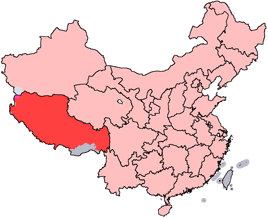Politics in Tibet
Politics in Tibet are structured in a dual party-government system like all other governing institutions in the People's Republic of China. Both the Chairman of the Tibet Autonomous Region and the Chairman of the regional People's Congress, are by law ethnic Tibetans. There is also a branch secretary of the Communist Party of China, who receives deference in disputes. Historically, the Dalai Lama also had political power sometimes.[1]
Era of the Lamas

The first Dalai Lama to rule Tibet was the fifth in 1642. The two Dalai Lamas before him were high ranked monks from the Gelug tradition of Tibetan Buddhism. The first two Dalai Lamas were assigned as such posthumously.
- Dalai Lama Lozang Gyatso (1617 - 1682)
- Regent Sonam Rapten (1642 - 1658)
- Regent Sangye Gyatso (1678 - 1703)
- Dalai Lama Tsangyang Gyatso (1683 - 1706) (did nearly not govern himself)
- Regent Ngawang Rinchen (1703 - 1706)
- Dalai Lama pretender Yeshe Gyatso (1706 - ±1708)
- Regent Kanchenne (- 1728)
- Dalai Lama Kelzang Gyatso (1708 - 1757) (did nearly not govern himself)
- Regent Polhanas (1728 - 1747)
- Regent Gyurme Nangyel (1747 - 1750)
- Regent, the sixth Demo Rinpoche (1757 - 1777)
- Dalai Lama Jamphel Gyatso (1758 - 1804) (did nearly not govern himself)
- Regent, the first Tsemonling Rinpoche (1777 - 1786)
- Regent, the eighth Kundeling Lama (1791 - 1811)
- Regent, the seventh Demo Rinpoche (1811 - 1818)
- Dalai Lama Lungtok Gyatso (1806 - 1815) (did not govern himself)
- Regent, the second Tsemonling Lama (1819 - 1844)
- Dalai Lama Tsultrim Gyatso (1816 - 1837) (did not govern himself)
- Regent, the third Reting Rinpoche (1845 - 1862)
- Dalai Lama Khendrup Gyatso (1838 - 1856) (did not govern himself)
- Dalai Lama Trinley Gyatso (1856 - 1875) (did not govern himself)
- Regent Dedruk Khyenrab Wangchuk (1864 - 1873)
- Regent, the tenth Kundeling Lama Tatsak Ngawang Pelden (1875 - 1886)
- Regent, the ninth Demo Rinpoche Lozang Trinlé (1886 - 1895)
- Dalai Lama Thubten Gyatso (1876-1933)
- Regent, the fifth Reting Rinpoche, Jamphel Yeshe Gyaltsen (1934 - 1941)
- Regent Taktra Rinpoche (1941 -1950)
- Dalai Lama Tenzin Gyatso (1935-1959; currently in exile)
1907-1952
Silöns (prime ministers) of the Ganden Podrang government:
- Changkhyim (1907-1920)
- Paljor Dorje Shatra (1907-1923)
- Sholkhang (1907-1926)
- Langdün Künga Wangchuk (1926-1940)
- vacant 1940-1950
- acting silöns: Lobsang Tashi and Lukhangwa (1950-1952)
Tibet Autonomous Region

The transition from Lamaist rule started in 1951 with the seventeen point agreement between the Central People's Government and the Dalai Lama. A "Preparatory Committee for the Autonomous Region of Tibet" (PCART) was established in 1956 to created a parallel system of administration along Communist lines. Transition to secular government completed when Tibet Autonomous Region was officially founded in 1965 according to the national autonomy law.[1]
Chairmen in the Tibet Autonomous Region
The Chairman is the nominal leader of the Tibet Autonomous Region, a province-level administrative division of the People's Republic of China. The Chairmen, and their times in office, are listed below. In practice, the Chairman is subordinate to the branch secretary of the Communist Party of China.
- Chairman of the Preparatory Committee
- 14th Dalai lama "Tenzin Gyatso" (April 1956 - March 1959)
- 10th Panchen lama "Choekyi Gyaltsen" (March 1959 - December 1964)
Chairman of the People's Committee - Ngapoi Ngawang Jigme (ང་ཕོད་ངག་དབང་འཇིགས་མེད་, first term)[1] (December 1964 - until the beginning of the Cultural Revolution)
Head of the Revolutionary Committee
As was the situation elsewhere in China, during the Cultural Revolution the regional government was replaced by a revolutionary committee. - Zeng Yongya (September 1968 - November 1970)
- Ren Rong (November 1970 - August 1979)
Chairmen of the People's Government - Sanggyai Yexe (སངས་རྒྱས་ཡེ་ཤེས), aka Tian Bao (August 1979 - April 1981)
- Ngapoi Ngawang Jigme (ང་ཕོད་ངག་དབང་འཇིགས་མེད་, second term) (April 1981 - May 1983)
- Doje Cedain (རྡོ་རྗེ་ཚེ་བརྟན་) a.k.a. Dorje Tsetsen or Duoji Caidan (May 1983 - December 1985)
- Doje Cering (རྡོ་རྗེ་ཚེ་རིང་) a.k.a. Dorje Tsering or Duoji Cairang (December 1985 - May 1990)
- Gyaincain Norbu (རྒྱལ་མཚན་ནོར་བུ་) (May 1990 - May 1998)
- Legqog (ལེགས་མཆོག) a.k.a. Legchog (May 1998 - May 2003)
- Qangba Püncog (བྱང་པ་ཕུན་ཚོགས་) a.k.a. Jampa Phuntsok(May 2003 - Jan. 2010)
- Padma Choling (པདྨ་འཕྲིན་ལས་།) (Jan. 2010 – Jan 2013)
- Losang Jamcan aka Losang Gyaltsen (January 2013 - present)
Secretaries of CPC
- Zhang Guohua (January 1950 - June 1951)
- Fan Ming (June 1951 - December 1951)
- Jingwu Zhang (March 1952 - August 1965)
- Zhang Guohua (September 1965 - until the beginning of the Cultural Revolution)
- Ren Rong (August 1971 - March 1980)
- Yin Fatang (March 1980 - June 1985)
- Wu Jinghua (June 1985 - December 1988)
- Hu Jintao (December 1988 - November 1992)
- Chen Kuiyuan (November 1992 - September 2000)
- Guo Jinlong (September 2000 - December 2004)
- Yang Chuantang (December 2004 - November 2005)
- Zhang Qingli (November 2005 - May 2006)
- Zhang Qingli (May 2006 - August 2011)
- Chen Quanguo (August 2011 - )
Chairmen of the Standing Committee of the People's Congress
- Ngapoi Ngawang Jigme (1979 - 1981)
- Yang Dongsheng (1981 - 1983)
- Ngapoi Ngawang Jigme (1983 - 1993)
- Raidi (1993 - 2003)
- Legqog (2003 - 2010)
- Qiangba Puncog (2010 -)
See also
- Central Tibetan Administration
- Politics of the People's Republic of China
- Constitution of the People's Republic of China
| ||||||||||||||||||||||||||||||||
References
- ↑ 1.0 1.1 1.2 "New Progress in Human Rights in the Tibet Autonomous Region". Information Office of the State Council of the People's Republic of China. February 1998.
